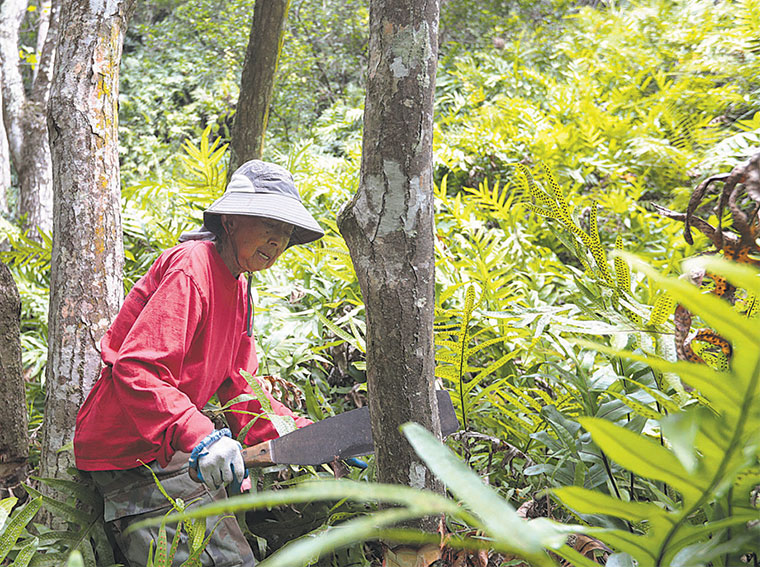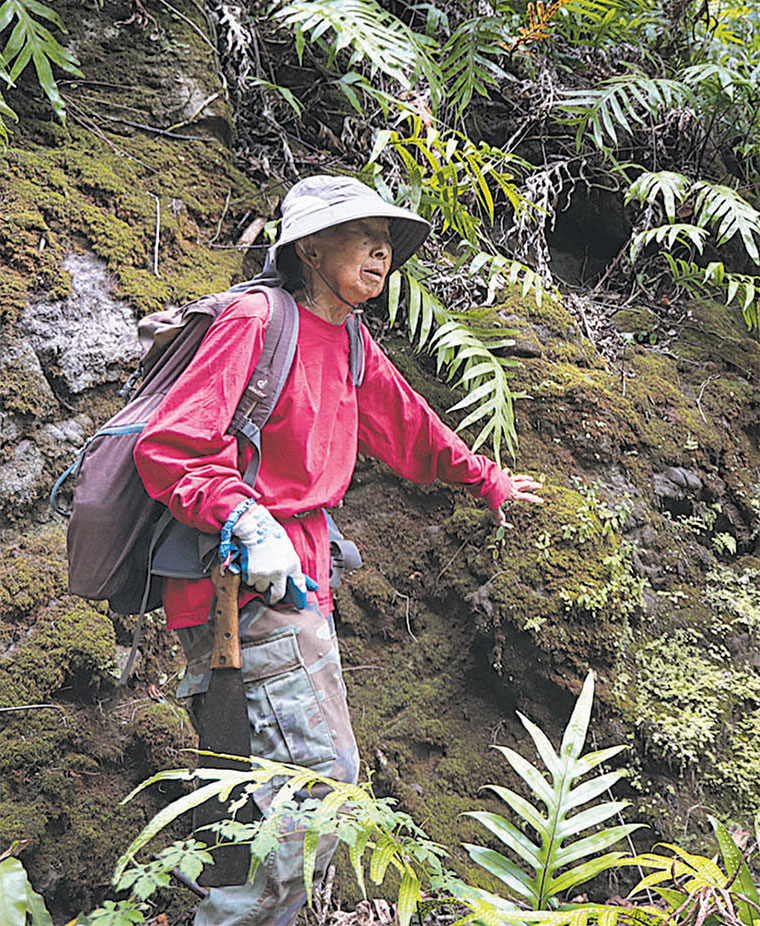
By Leila Fujimori
Don’t let her diminutive size fool you. At just 4-foot-9 and 65 pounds, Charlotte Yamane is a powerful and effective killer, typically using a machete, occasionally poison and often her bare hands.
The 81-year-old is legendary in environmental and hiking circles for her work in eradicating invasive alien plants and planting native ones in their stead.
Yamane dedicates three days a week to her work, scaling mountains at times, to bring down massive trees, clear tangles of suffocating vines and zero in on other invasives.
“She’s an unsung hero,” said John Morgan, president and owner of Kualoa Ranch, where she volunteers with its stewardship team to do eradication and propagation.

“She is absolutely wonderful. I would imagine (she’s eradicated) in the hundreds if not thousands of invasive trees, with a number of target species she goes after.”
Morgan first met her when she was physically lifting up moss rocks into a truck for a former employer. He hired her to run the ranch’s tropical flower operations in the 1980s.
“I was very impressed with her capabilities,” he said. “Her dedication to the native flora and fauna is just amazing.”
But what motivates Yamane to do such rigorous work, not just occasionally, but some 20 hours every week?
“I have a goal,” she said. It’s an inner drive to rid the island of invasive plant species that have smothered native plants and all too easily overtaken much of the native forests in Hawaii.
“I first started killing albizia,” Yamane recalled about the start of her battle against invasives. It was sometime in 1977 or 1978, near her rented house deep in Kalihi Valley, she said. “I used to just girdle (severing the bark and several layers of the trunk) without poison. I didn’t know how to kill it before. I just used to whack it with the machete, just cut, cut all around. You have to cut down into the cambium layer (growing part of the trunk).”
AFTER SHE and her husband briefly moved to Oregon in 1993, she returned to visit the area and discovered it had been overrun by albizia, leaving the dirt road that led to the house impassable.
“I was shocked how tall they got,” she said. “I started killing trees.” Again. “Back in the 1990s, people would be so angry at you,” Yamane said. “‘Why did you do that? It’s such a beautiful tree. It took years to grow that.’”
She was told to stop because the dead branches and eventually whole trees would fall, which could endanger property and lives.
But Yamane, a onewoman army and ahead of her time, was not to be deterred. As a member of the Hawaiian Trail and Mountain Club since 1976, she participated in Sunday trail clearings. But she would hang back if she saw an invasive tree along the way and kill it.
Then in 1995, Yamane spotted her first miconia leaf (an invasive plant) in Hoomaluhia Park and asked park personnel about it. “They didn’t know, so I took it to the state Agriculture Department and they freaked out,” she said. “I took them to the place where I found it. That was the start.”
Without any herbicide, she would just pull them out. The state would eventually make a concerted effort to battle miconia, one of the more aggressive non-natives in Hawaii.
Yamane volunteered once a week from about 1998 to 2000 with the Oahu Army Natural Resource Program, and credits Kapua Kawelo and Jobie Rohrer for imparting a lot of knowledge on “how to kill using herbicides. I shouldn’t use the word kill,” she said. “Eradicate.”
With her asthma and chronic obstructive pulmonary disease, she could no longer keep up with younger club members and now limits hikes to four miles a day, but that’s fine with her.
“I don’t like crowds,” she said. “It’s much more peaceful by yourself.” Still, she has a couple of like-minded friends who join her. YAMANE HAS RETURNED to her native Kaaawa, where she grew up with a love of the outdoors and continues to enjoy the beauty of plants, especially native ones.
She volunteers twice weekly at Kualoa Ranch to hunt down invasive trees and monster vines like the passiflora lorii.
When she first began, Yamane focused on the albizias near the roadway, then gradually moved up to the 800-foot elevation.
“You just climb. Sometimes you can hold onto trees and branches,” she said.
Sometimes, Yamane and a buddy might decide to visit a site where a special ukiuki, native to Hawaii, grows. “We don’t just hike around and admire the plants. We kill stuff as we’re going. We don’t get satisfaction until we kill something good.”
On Thursdays she joins a group of seniors above the Kunia farmlands, where they have been trying to restore the native forest.
The work is not easy. She tore her miniscus in November. “I try not to limp,” she said. “Hiking is good. In the house I limp, but on uneven ground I have to concentrate. It’s good to exercise and strengthen my muscles.” She says her husband, Volker Hildebrandt, who cleans the house and cooks, is her biggest supporter and allows her the time to “do her thing.”
She believes her love of the outdoors is hereditary. “My mother fished and loved plants. My dad, who was a carpenter, fished. And my grandmother worked in the ‘hatake’ (vegetable garden) until her 90s.”
Yamane said she won’t stop what she’s doing, “even if I have to crawl or hitch a ride on somebody’s back.”
See More News